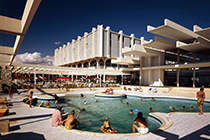
|
Holidays after the Fall Transformations of socialist holiday architecture on the Croatian Adriatic 05.11. – 30.11.2015, HALLE F3 OPENING: WEDNESDAY, 04.11.2015, 7PM The tourist industry represents the key economic sector in Croatia. It is built on an infrastructure that was developed during the Socialist drive to modernise in the 1960s and '70s – an era when priority was given to spatial planning, and explicit modernity in architecture and art were key to the nation's corporate design. The exhibition provides a geneology of large-scale holiday architecture on the Adriatic coast, including the physical and economic tranformations undergone by these complexes since the collapse of Yugoslavia. The projects concerned are of a remarkably high quality, although today — depending on their location, and the new owners — they have become melancholy ruins, been simply renovated, or innovatively redeveloped. The exhibition opens with Tito's historic call to "Come and see the truth" that was used to advertise the large-scale tourist complexes self-administered by the socialist labour force as transnational centres for encounter. In contrast to the Soviet Socialist countries behind the Iron Curtain, Yugoslavia had a policy that promoted internationalism, with open borders, an economic policy between Socialism, and a self-administered free market, while playing a leading role among the Non-Aligned States. The central design element of the exhibition is a 15 metre long timeline with graphics showing bed number statistics. These have shown a steady rise since 1955, first peaking in 1988 and then slumping with the beginning of the war in 1991, a slump from which the Croatian tourist industry was to take a long time to recover. Seven selected case studies provide examples for the discussion of relevant topics: social tourism, the demands of spatial planning, the diversity of building types, interior design, art and design — privately owned serviced apartments in times of legal uncertainty and economic crisis, as well as whole resorts abandoned and in ruins. Aspects of the planning history and structural transformations are illustrated, and outlines are provided of the political and economic background to the privatisation processes, including the occasional idiosyncrasy. Into whose possession the hotels and resorts have fallen, when and how are not irrelevant, nor is the background to the owners' operations today. Exhibition transfer from Haus der Architektur Graz (2012), curated by Michael Zinganel Historic Consultants: Maroje Mrduljaš and Norbert Mappes-Niediek Project Coordination, Az W: Katharina Ritter Contributors: Daniele Ansidei, Arhitektura, Zoran Balog, CCN-images, Čovjek i Prostor, Marko Dabrović, Antonia Dika, Nikolina Džeko, Cemal Emden, Damir Fabijanić, Fotoklub Split, Michael Hieslmair, Hrvatski muzej arhitekture, Ryan Jeffery, Jana Jocif, 3LHD, Miran Kambič, Julie De Luca, Boris Magaš, Maistra, Rikard Marasović, Norbert Mappes-Niediek, Maroje Mrduljaš, Branimir Medić & Pero Puljiz – de Architekten Cie., Boris Podrecca, Andrea Seidling, Kerstin Stramer, Tabanlıoğlu Architects, Wolfgang Thaler, Touristkomerc, Urbanistički institut Hrvatske, Valamar, Cat Vinton, Michael Zinganel Supported by: VALAMAR Hotels & Resorts Recommended Reading: Elke Beyer, Anke Hagemann, and Michael Zinganel (Eds.): Holidays after the Fall: Seaside Architecture and Urbanism in Bulgaria and Croatia, JOVIS, Berlin 2013 Press Contact: Ines Purtauf, Tel.: +43 1 522 31 15-25, E-Mail: purtauf@azw.at, presse@azw.at Public Funding: Urban Planning, Traffic & Transport, Climate Protection, Energy and Public Participation Bundesministerium für Unterricht, Kunst und Kultur Geschäftsgruppe Kultur und Wissenschaft Sponsor: ARCHITECTURE LOUNGE |
 |
|
© ccn-images Zagreb |
|
Press page Current events Past events Dates: Holidays after the Fall Downloads: PRESS RELEASE: Holidays after the Fall PRESS_Valamar Riviera Information: Ines Purtauf Tel.: +43 (1) 522 31 15 - 25 Fax: +43 (1) 522 31 17 Email: purtauf@azw.at |
| © Architekturzentrum Wien 2025 |
||



